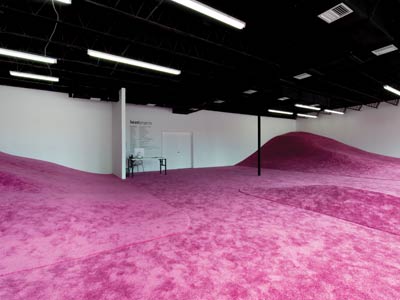 For something quite minimal, albeit sprawling and undoubtedly time consuming, Leyden Rodriguez-Casanova’s An Uneven Floor exhibition at Locust Projects evokes many possible reads. All the implications the work holds may not be immediately detectable. To many it may feel, in part due to the color of the carpet that inundates the floor of the entire 2700 square foot space, like kitsch run amok. But in the context of Rodriguez-Casanova’s work, and given his fixation, among other things, in environmental psychology that is astutely applied to his works, An Uneven Floor is rather compelling. That this single material en masse is able to instigate several different conversations is very interesting, and reveals his conceptual artistic prowess.
For something quite minimal, albeit sprawling and undoubtedly time consuming, Leyden Rodriguez-Casanova’s An Uneven Floor exhibition at Locust Projects evokes many possible reads. All the implications the work holds may not be immediately detectable. To many it may feel, in part due to the color of the carpet that inundates the floor of the entire 2700 square foot space, like kitsch run amok. But in the context of Rodriguez-Casanova’s work, and given his fixation, among other things, in environmental psychology that is astutely applied to his works, An Uneven Floor is rather compelling. That this single material en masse is able to instigate several different conversations is very interesting, and reveals his conceptual artistic prowess.
Although he says, “pink creeps into my work every now and then in large amounts,” and is a color he feels is autobiographical in terms of his domestic upbringing, it’s the structure that is more important. The combination of organic forms and functional architecture has allowed him, in this work, to create something with more existential undertones. While thinking about his work prior to the show he says “a particular saying kept popping into my mind: having both feet firmly planted on the ground.” The phrase of course, metaphorizes stability and control with a certain sense of autonomy. Taking away the primary role of this architecture then, he says, turns this notion on its head. “Especially a floor needs to be firm, solid, flat. Combining that with an outdoor/organic environment gives a feeling opposite of firmly planted feet.”
This idea reaches back to his previous works; a re-contextualizing of objects from a familiar vocabulary – that of which he describes as having a utilitarian nature. It reaches first in the pre-supposed function of the material itself: carpet. Carpet is something to make a home or living space more comfortable. And second being that feeling more comfortable often means feeling more safe. Carpet that is laid underfoot does not typify an art object – in fact many people are not used to experiencing art this directly; another boundary Rodriguez-Casanova pushes in his work. “Familiar architecture and structures in the domestic world are fashioned for human interaction”, he says, “and they seem to communicate that quality often in an obvious way.” This vocabulary is something he has come to work with because he can manipulate it – “you already understand these objects’ functionality. I’m offering a starting point to a new dialogue.” He wants viewers to experience and contemplate the work, and says, “A lot of times art is lacking the most primary sense we have, which is touch.” The plush, inviting tactile quality of the carpet, in conjunction with its color seems at first sort of jovial; comfortable. But negotiating the unpredictable topography of the floor that lies beneath it compromises the stability of the viewer – and this does in effect dismantle the firmly planted feet idea. To read this more personally and metaphorically, the piece could be viewed as an expression of an emotional state Rodriguez-Casanova is or was experiencing.
“Place Identity” is a particular granule in environmental psychology he is examining with his work; looking at studies of how people relate to the world/environments around them via environment identity – that is they view and analyze it through the lens of their own immediate surroundings and their history with them. In personalizing the world at large, people are able to make it more manageable and relative to them. It seems this practice is likely innate, and therefore yields a fairly universal language or point of reference that Rodriguez-Casanova takes advantage of. “Although domestic environs are the most intimate and personal”, he says, “there are still components that are pretty universal”. This process for him had more direct personal beginnings. Initially, rather than very simple objects re-configured and re-defined, he used actual photographs from his childhood experiences. Over time, and due to the artistic editing process, he began to focus in on the details of the pictures – not of the people, but the backgrounds. “By focusing in, I actually pulled back from the work… from being so personal, to open the dialogue even further.” This revision and simplification led to the stark, lonely sculptures, comprised of actual blinds, gates, and sofas that are resonant both in and out of his culture and specific upbringing. Although An Uneven Floor does hold personal meaning for him, others come to it with their own identities, nostalgia, taste, and experience – and it is this that creates conversation.
But of course it’s also nice to have some insight from the fabricator himself. His perspective offers an interesting look at material choices. Keeping in sync with his conceptual analysis of environmental identities is his interest in what he calls a working-class aesthetic – one driven only by convenience and economic ability. “It’s what I grew up in,” he says, and he finds there is a kind of innocence in this often brightly-colored, arbitrary visual taste. The choices are uneducated, and purely concerned with income – and carry a kind of distinction that he deftly directs in his work. This is a form of decision-making he relates to. Because re-creating them out of expected art materials would remove much of this intrinsic meaning, it’s important to him to use the actual objects and materials of this incidental aesthetic faction. “An Uneven Floor is a big project,” he says, “but I always look for the cheapest materials.” It’s true – Chenille carpet just wouldn’t be the same. This is one more aspect that blows the notion of untouchable art – he is less concerned with preservation and archival materials than the institutional world would have. And having been exposed to trade work in his youth prior to studying art he “doesn’t want to go into the art world only to do what “he” was trained to do.” Like the largely unintentional working class aesthetic, he too feels that he is educated during the process by accidents. “In trade”, he says, “all kinds of limitations are encountered, and factors that change the end result emerge all the time.” Also, by adapting pre-created materials into his work, he touches on the labor that went into constructing the original objects themselves. This calls into question the social-labor hierarchy, and simultaneously relates back to the working class and tradespeople.
Encountering an exhibition like An Uneven Floor can be surprisingly jarring. Fuzzy, rolling hazards encroach and sneak-up from all sides, and you can’t be in the space without being on top of, and therefore a part of the piece. Many relayed a resulting sense of anxiety, even terror akin to domestically-set horror films. While the feeling of falseness isn’t completely ignorable, though, Rodriguez-Casanova’s work doesn’t feel like a staging some much as a statement. It’s a concise and methodical point that is raised by re-presenting the obvious. Here, it is merely a continuous interior of carpet – the twist being the uneasy terrain in an unexpected context, and the forced interaction between the work and the viewer. Beyond that, it is up to them to react and interpret, and ultimately join in the discourse. The possibilities are many. Perhaps we take for granted the impact our visual surroundings have on us over the years. Maybe we have settled on a certain level of mediocrity; making a sacrifice for convenience. Maybe being confronted with work like this makes us feel anxious because it provokes us to re-examine our aesthetic choices. Or maybe all of this is subconscious – just a psychological after effect of our own personal visual histories that we can’t see past. After all, however informed, this is only one person’s read.

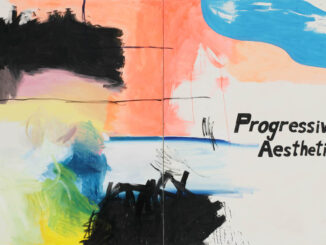
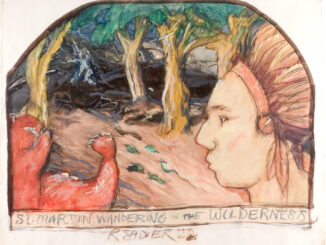
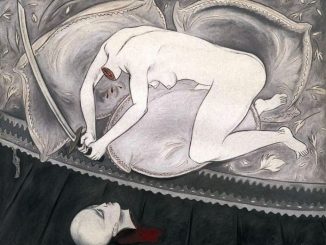
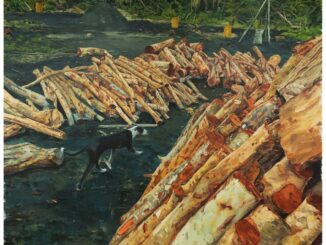

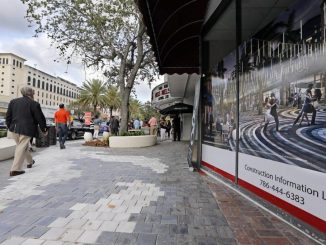
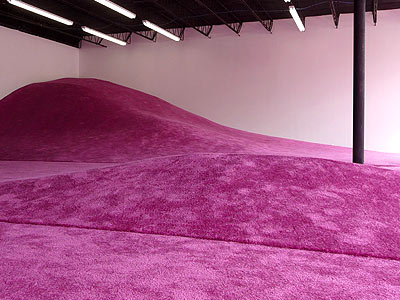 Locust Projects is currently presenting an exhibition by Miami-based artist Leyden Rodriguez-Casanova. An Uneven Floor is a site-specific installation featuring an unleveled floor covered in pink carpet. The work represents Rodriguez-Casanova’s most ambitious project to date, encompassing the entire 2,700 square foot gallery space.
Locust Projects is currently presenting an exhibition by Miami-based artist Leyden Rodriguez-Casanova. An Uneven Floor is a site-specific installation featuring an unleveled floor covered in pink carpet. The work represents Rodriguez-Casanova’s most ambitious project to date, encompassing the entire 2,700 square foot gallery space.
Be the first to comment